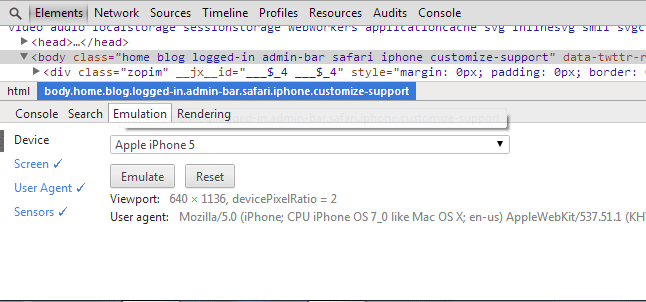

- #Mac chrome device emulator how to#
- #Mac chrome device emulator for mac#
- #Mac chrome device emulator mac os#
- #Mac chrome device emulator install#
- #Mac chrome device emulator android#
Then, select ‘Network’ in the emulation drawer: Open the DevTools emulation drawer by clicking the ‘More overrides’ icon in the top right corner of the browser viewport. You can even change the Operation System version of mobile device. To turn off mobile emulation without exiting device mode, click the ‘Reset all overrides’ icon and refresh the page: Right-click a bar to view where the media query is defined in CSS and jump to the definition in source code: Wouldnt it be great to use the same DevTools in this emulated environment This cloud-based emulator works well with Android, Mac and Windows devices and is. To preview screen styles, click a media query bar to adjust the emulator resolution and preview styles for the targeted screen sizes: For example sake, I chose the iPhone 6 Plus.

#Mac chrome device emulator mac os#
Basically, it ported enough of Mac OS to Windows to run Safari like a Mac. After this appears youll be able to select which device to emulate in chrome. Orange: Queries targeting a minimum width. Google chromes Dev Tools, available when you press F12 in Chrome will allow.
#Mac chrome device emulator android#
BlueStacks 2 is a free Android emulator that runs on macOS and Windows, so no matter what kind of personal computer you have, you can try out Android apps. Green: Queries targeting widths within a range In addition to running Android apps on a Mac-turned-Chromebook or in the Chrome Web Browser, there’s actually a way to run a pseudo-Android device on your Mac. Media queries are color-coded as follows: The DevTools detect media queries in your stylesheets and display them as colored bars in the top ruler: To view the media query inspector, click the ‘ Media queries’ icon in the upper left corner of the viewport.
#Mac chrome device emulator how to#
Did you know: How to remotely debug Safari on macOS and iOS Devices. To emulate a custom screen size, manually set the CSS pixel dimensions of the device in the width and height fields:ĭevice mode makes media queries readily accessible and easy for you to inspect. You can inspect elements of a website in your Android device using Chrome browser. Select the ‘Fit checkbox’ radio button to ensure that the emulated screen remains fully visible inside your browser viewport: Select a model from the preset dropdown to emulate a particular device:Įach preset automatically configures device emulation in the following ways (sets the device resolution and pixel ratio, enables touch emulation, etc).Īlternate between portrait and landscape views by clicking the ‘Swap Dimensions’ icon. The screen emulator helps you test the responsiveness of your website, it has a variety of emulation presets. NativeScript uses Xcode to build and run iOS apps, and Xcode is only available on macOS. You can also toggle device mode on/off using the keyboard shortcut: Launches the app on a connected iOS device or iOS simulator. When device mode is enabled, the icon turns blue and the viewport transforms into a device emulator: Turn on device mode by pressing the Toggle device mode icon. Open your website, using Google Chrome browser. How to use Google Chrome Device Emulation feature To enable Device Mode This feature will help you to test your responsive designs by emulating different screen sizes and resolutions.
#Mac chrome device emulator install#
If you have a Windows PC, you’ll still need to install and run an Android emulator for Windows 10 to use the Google Home app.
#Mac chrome device emulator for mac#
If you’re setting up Google Home for Mac to a Google Chromecast device, follow our guide on how Chromecast works and how to use Chromecast to cast your entire desktop to TV. Once BlueStacks and Google Home app are set up on your Mac, it’s only a matter of setting up your connected devices.

Select Install and then select Open once Google Home app finishes downloading.



 0 kommentar(er)
0 kommentar(er)
